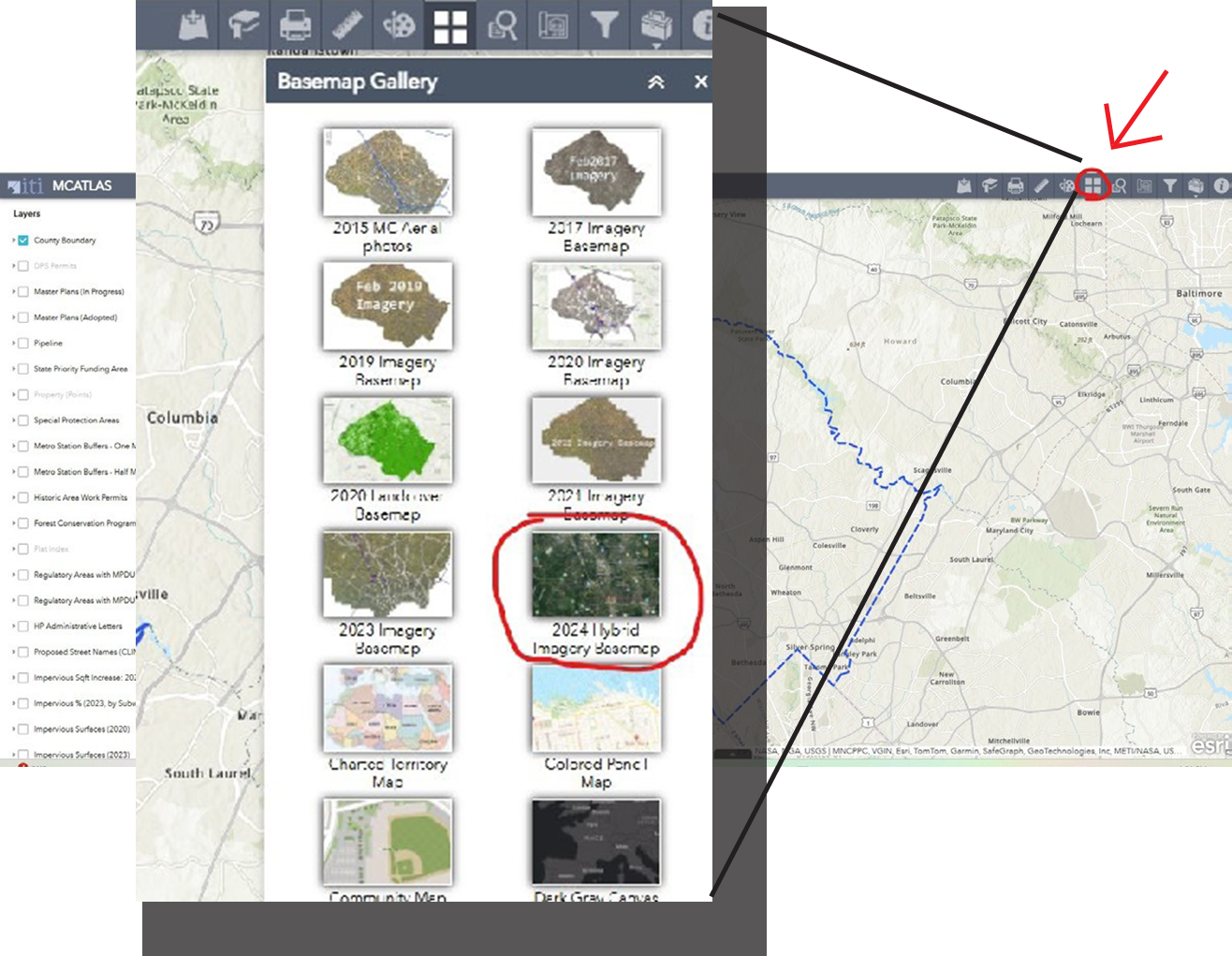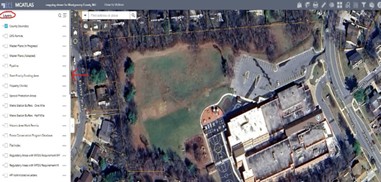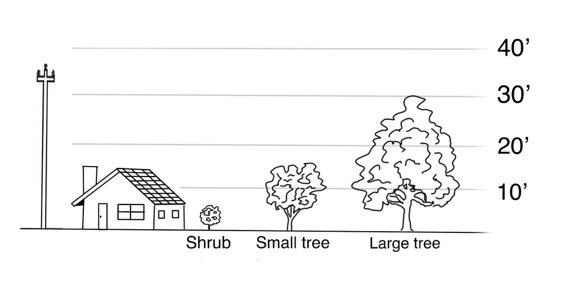RainScapes for Schools: Environmental Stewardship Report Card
Back to RainScapes for Schools
Follow this report card to find out how well your schoolyard helps to protect local water sources within our watershed. You may also download and print the report card (PDF).
- Learn vocabulary that will be used in the assessment.
- Start mapping your schoolyard.
- Complete the assessment for your report card!
Definitions
- Bioretention: A stormwater management practice that uses soil and plants to filter and clean stormwater runoff.
- Canopy Tree: A tall tree that has a thick, leafy top (canopy) that provides shade and shelter for animals and plants.
- Conservation Landscape: A garden or landscape area that is designed with native plants and functions like a natural ecosystem. It often uses plants that require less water to survive and provides food or habitat for wildlife and pollinators.
- Erosion: The process where wind, water, or ice slowly wears away soil, rocks, or land over time.
- Forested buffer zone: A strip of trees or plants along rivers, lakes, or streams that helps clean the water. Buffers stop pollution from urban or agricultural areas flowing into rivers. They also, helping to keep water temperatures lower for organisms that depend on the water.
- Impervious: A surface that doesn’t allow water to pass through it, like concrete, asphalt, or roofs.
- Invasive: Plants, animals, or insects that are not native to an area and can harm the local environment.
- RainScape: A landscape or design technique that helps reduce stormwater runoff from individual properties. They allow stormwater and pollution to soak in and be cleaned by soil rather than flowing into storm drains which lead to streams.
- Rain garden: A garden specially designed with 75% native plants and spongy soil to collect stormwater from downspouts or hard surfaces with up to 6" of ponding that drains quickly. They absorb and filter water, reduce flooding and erosion, and provide habitat.
- Runoff: Rainwater or melted snow that flows over streets, sidewalks, or lawns, carrying soil, pollution, or debris with it.
- Storm Drain: A system of pipes or tunnels that collects and carries stormwater away from streets or other areas; many drain directly into streams.
- Stormwater: Rain or melted snow that quickly accumulates during a storm event and flows over the ground where it can’t soak in quickly, such as in streets or hard ground.
School mapping exercise
Go to the Montgomery County Planning Department's MCAtlas map viewer. Click OK on the welcome message.
Find your schoolyard

- Go to the location bar circled in red to the left.
- Type in the name of your school and select the location when it appears. If the name of your school does not show-up, use the address.
- After selecting the school, the map should move to the school location. A property line will be drawn around the school building and surrounding space- this whole area is considered the "schoolyard" when filling out the Report Card.
Turn on a basemap and information layers

Select the base map icon in the upper right corner of the screen. The map to the left circles it in red. When the options appear, select 2024 Hybrid Imagery Basemap.
Select layers and sublayers

Select the following 4 layers and sublayers by clicking the box to the left of their name:
- Forest Conservation Easements
- Environmental Features- use the drop down menu to select Stormwater Facilities (this will show major drains on the property, use the dropdown arrow for this layer to see the legend that explains the colors for the drains)
- Contours
- Watersheds- use the dropdown arrow to select Biomonitoring Subwatersheds (2016-2021; MCDEP). The color on the map tells you the watershed quality and will help you answer the first question in the next section.
Use your mouse or the plus and minus sign on the upper left of the map area to zoom in or out to have a closer look at your schoolyard and its features. Some map layers are only visible at certain zoom levels.
You can also try other layers under the Environmental Features option to see if your school has floodplains or wetlands nearby or to learn about soil types on the property.
What is a Watershed?
A watershed is an area of land that drains to a common body of water, such as a river, lake, or bay. The boundaries of a watershed are defined by the highest elevation ridge that surrounds a waterway or network of waterways.
- While the Biomonitoring Subwatersheds (2016-2021; MCDEP) is highlighted in the layers list of the map viewer, select the color where your school is located.
- An information box should appear that lists your watershed and local stream conditions.
Stormwater runoff/erosion
- Can you tell where your school’s roofs drain? If no, leave blank. Down- spouts drain rainwater directly into (choose one):
_____ A rain garden or conservation landscape (10 points)
_____ Well-vegetated area with trees and shrubs or un-mowed grass (8 points)
_____ Mowed grass (5 points)
_____ Impervious surface, bare soil, or a mulched area with few to no plants (3 points)
_____ An even mix of all of the above (6 points)
_____ Directly into storm drains (0 points) - Look for patches of bare soil and signs of erosion such as areas where rainwater has carved out ditches or washed-out vegetation. The schoolyard has (choose one):
_____ Very little erosion and few patches of bare soil (10 points)
_____ Several patches of bare soil or areas where soil is eroding (7 points)
_____ Mostly bare, exposed soil or impervious surfaces (0 points) - Impervious surfaces like sidewalks, roofs, or parking lots contribute to stormwater accumulation. Does your school have any of the below to help capture the stormwater? (choose all that apply):
_____ Rain Garden (3 points)
_____ 10+ Canopy Trees providing cover to rooftops or roadways (2 points)
_____ Conservation Landscape (2 points)
_____ 50 feet or more of a forested buffer zone surrounding any streams or creeks running through or near the schoolyard (3 points) - After looking at your schoolyard map, describe where in this range it falls. (The circled number counts as points towards the total): 1 2 3 4 5 6 7 8 9 10
(1 = Entirely made of impervious surface) (10 = Mostly forested)
Vegetation
How do invasive plants harm the environment?
Invasive plants spread quickly and crowd out native plants by competing for space, sunlight, water, and nutrients. This can cause a decline in native plants and the native animals or insects that depend on them for food, shelter, or nesting spots. Some invasive plants produce chemicals that are toxic to animals or prevent other plants from growing.
 Describe the vegetation at your school (use the diagram as a reference to estimate tree heights compared to utility poles and houses):
Describe the vegetation at your school (use the diagram as a reference to estimate tree heights compared to utility poles and houses):
_____ Large trees (25’ or higher) and bushes cover most of the school- yard (10 points)
_____ Small trees ( <25’) and bushes cover most of the school yard (8 points)
_____ Large trees (25’ or higher) and bushes dot the landscape of the schoolyard (5 point)
_____ Small trees ( <25’) and bushes dot the landscape of the school- yard (3 points)
_____ There are few to no trees and bushes on the schoolyard (1 point)-
View educational resources about invasive plant species of concern in our area, such as the RainScapes Invasive Plants of Concern (PDF), Common Invasive Plants Easy ID Cards (PDF), Plant Invaders of the Mid-Atlantic, and Introduction to Invasive Plants of Maryland.
Then describe the invasive plant situation at your school:
_____ There are no invasive plants present on the schoolyard (10 points)
_____ There are minimal invasive plants present (8 points)
_____ There is a significant amount of invasives present on the ground, but not climbing the trees. (3 points)
_____ There is a significant amount of invasives present on the ground and climbing trees (1 point) - How much of the grass and vegetated areas in your schoolyard are being mowed?
_____ Less than 50% (10 points)
_____ Between 50% and 80% (6 points)
_____ Over 80% (1 point) - Describe the vegetation in the lowest-lying part of your schoolyard (choose one). View a photo reference for native plants.
_____ Well vegetated with native trees and shrubs (10 points)
_____ Well vegetated with un-mowed grass (6 points)
_____ Well vegetated with plants (4 points)
_____ Mowed Grass (3 points)
_____ Bare soil, pavement, or concrete (1 point)
Biodiversity
Animal Habitats
A habitat is the natural environment where an animal or plant lives. It provides everything the organism needs to survive, such as food, water, shelter, and space. Humans are animals too, but unlike other animals, we build habitats that change large areas. Cities, roads, and farms take away habitat that other animals need to survive. As animals cross into our built habitat to search for food and shelter, it creates problems for both animals and people.

- By counting the different types of leaves on canopy trees, how many different types of canopy trees are there on your schoolyard? (The illustration above provides some different leaf or needle shapes and characteristics to note)
_____ 10 or more (10 points)
_____ 7-9 (8 points)
_____ 4-6 (5 points)
_____ 2-4 (3 points)
_____ 1 (1 point) - By counting the different types of leaves on shrubs, how many different types of shrubs are there on your schoolyard?
_____ 10 or more (10 points)
_____ 7-9 (8 points)
_____ 4-6 (5 points)
_____ 2-4 (3 points)
_____ 1 (1 point) - By counting the different types of leaves on plants that are not trees or shrubs, how many different types of other plants and grasses are in the gardens on your schoolyard?
_____ 20 or more (10 points)
_____ 15-19 (8 points)
_____ 10-14 (5 points)
_____ 5-9 (3 points)
_____ 1-4 (1 point) - Below are examples of habitats for animals. Choose any of the following that apply to your schoolyard:
_____ Woodlands with many different layers of plants and trees (2 points)
_____ Tall grassy fields and meadows (2 points)
_____ Thick brush, brambles (a prickly vine or shrub), or a brush pile (2 points)
_____ Dead standing trees or rotting logs on the ground (2 points)
_____ Gardens with native plants (2 points)
_____ None of these (-1 point)
Transportation
Montgomery County Public School System (MCPS)
MCPS is Maryland’s largest school district and has over 200 schools, more than 160,000 students, and over 24,500 employees! More than 26 million square feet of MCPS buildings have stormwater run-off, and there are A LOT of people that need transportation. Think about all of the pavement and parking lots needed for so many people! There are over 1,300 buses that transport over 103,000 students to and from school traveling more than 112,000 miles! Buses are stored at 5 bus depots across the county. In 2021, MCPS Board of Education approved a project to convert 326 school buses to electric by 2025.
- Does your school have any parking areas that use permeable asphalt, porous concrete, or permeable pavers? The Stormwater Best Management Practices (PDF) by the USA Environmental Protection Agency provides more information on these materials.
_____ Yes (10 points)
_____ No (0 point) - Determine the number of students at your school by asking the office staff. Then determine the number of students who arrive at school in a bus and not a car. Compare the two numbers to determine the percentage of students arriving by car. If 50% or more of students arrive by car, the school may need to look at safe routes to school or the available bus routes:
_____ 25% or less of the students arrive in a car (10 points)
_____ 50% of the students arrive in a car (7 points)
_____ 75% of the students arrive in a car (3 points)
_____ 100% of the students arrive in a car (0 point) - Are there bicycle racks at your school, and do people use them?
_____ There are more than 4 bike racks, and they are full of bikes (10 points)
_____ There are between 2 and 4 bike racks, and they are full of bikes (8 points)
_____ There is one bike rack, and it is full of bikes (5 points)
_____ There is one bike rack, and it is not very full (3 points)
_____ There are no bike racks (0 point) - Is there any reward or encouragement for teachers or students who walk to school, ride their bikes, carpool, or take public transit?
_____ Yes (10 points)
_____ No (0 point) - Look around the parking lot at the slope, low points, and if there are any signs of water movement- such as moved debris, sand, silt or mulch. Can you tell where most of the rainwater drains after hitting the parking lot? (choose one)
_____ Bioretention (10 points)
_____ Mowed area or slightly vegetated drainage ditch (4 points)
_____ Storm drain marked "Chesapeake Bay Drainage" (2 points)
_____ Unmarked storm drain (1 point)
Awareness
Outdoor Classrooms
Outdoor classrooms provide safe spaces that combine academic lessons with hands on experiences in nature. Some are well- developed spaces with a lot of structure while others may be a few stumps in a garden or an area with a raised bed. They all have many benefits for students and staff. If you are interested in creating an outdoor classroom at your school or adding installed habitats, contact the Montgomery Public Schools (MCPS) Live Infrastructure Manager in the Division of Sustainability and Compliance to discuss any plans before installations.
- Does your school have any of the following classes/clubs? (choose all that apply)
_____ An environmental or garden club (5 points)
_____ An environmental science class (5 points)
_____ A watershed or soils unit in science class (5 points) - Does your school have any of the following energy saving techniques? (choose all that apply)
_____ LED bulbs (5 points)
_____ Sky lights (5 points)
_____ Green roof (5 points)
_____ Signs reminding you to turn off lights (5 points) - Does your school have any of the following water-saving techniques? (choose all that apply)
_____ Auto shut-off faucets (5 points)
_____ Low-flow faucets or water fountains (5 points)
_____ Dual flush toilets (5 points)
_____ Rainwater harvesting (5 points) - Does your school have any installed habitats for animals? (choose all that apply)
_____ Bluebird boxes (5 points)
_____ Bat boxes (5 points)
_____ Butterfly gardens (5 points)
_____ Ponds (5 points)
_____ Rain garden (5 points)
_____ Conservation Landscape (5 points) - Does your school have an outdoor garden classroom (no= 0 points)? If so, how often is it used and what features does it have (choose all that apply)? 1 2 3 4 5 6 7 8 9 10 (0 = Not used) (10 = Used frequently)
_____ Vegetable Garden (1 point)
_____ Pollinator Garden (1 point)
_____ Pond (1 point)
_____ Walking Trail (1 point)
_____ Benches/Seating or Tables (1 point)
Total score
Add your totals
Runoff/Erosion: ______
Vegetation: ______
Biodiversity: ______
Transportation: ______
Subtotal: ______
+ Awareness bonus points: ______
Total score: ______
(Maximum total: 270 points)
What's my school's grade?
200-270 (A+): Your school is leading the way in providing healthy habitats for learning!
150-199 (A-B): Your school is an excellent habitat for many plants and animals and is a very healthy part of the watershed!
110-149 (C-D): You are on the right track but there is more work to do to protect local waterways.
109 or less (F): Poor habitat. Many schools fall into this category, so please help us in making your schoolyard a better place by installing a RainScape!
Improve your stewardship
Runoff/erosion
- Convert underutilized grassy areas into gardens with layered vegetation and native plants.
- Install RainScapes stormwater gardens for run-off control next to parking lots and roads.
- Contact Tree Montgomery to plant a Canopy Tree near pavement or a playground.
- Volunteer with the county for a storm drain art or storm drain marking project.
Vegetation
- Plant a pollinator-friendly RainScapes stormwater garden with educational signage.
- Begin your own micro-nursery for tree plantings.
- Allow an area to become a no-mow zone.
- Remove invasive plants and replace with natives.
- Contact Tree Montgomery or Reforest Montgomery to plant free native Canopy Trees in the schoolyard and at home.
Biodiversity
- Plant native plants that benefit the environment and restore habitat.
- Select plants and schoolyard maintenance plans that provide year-round food and shelter for birds and insects (in areas safe from being disturbed).
Transportation
- Encourage your school to incentivize carpooling and use of public transportation.
- Install bike racks and get involved with advocating for safe routes to schools.
Awareness
- Create a school resource to educate others.
- Do this activity at home.
- Organize a community clean-up.
- Learn more about how native or invasive plants benefit or harm local ecosystems.
- Get involved with your local watershed group.